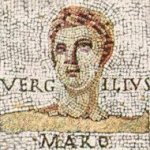Name: Aeneid (Latin:)
Also Known As: N/A
Date: 29 B.C.E and 19 B.C.E
Author(s): Publius Vergilius Maro

Depiction of Virgil, 3rd century AD
.Courtesy of WikiCommons, Giorces, Mattes.
Type of Text: Epic Poem
Genre: Latin Epic Poetry, Mythology, Foundation Story,
Content: A foundation story similar to Iliad and Odyssey that highlights the adventures and journeys of the Greco-Roman hero Aeneid. The piece is thought to be part of Augustan propaganda to the greatness of Rome and the Julio-Claudian family.
Type of Latin: Classical Latin
Distinguishing Features: (1). It comprises 9,896 lines in dactylic hexameter. (2). The Aeneid is a cornerstone of the Western canon, and early (at least by the 2nd century AD) became one of the essential elements of a Latin education, usually required to be memorized.
Where is it today:
There are no original surviving copies.
The Vergilius Vaticanus (Cod. Vat. lat. 3225, also known as the Vatican Virgil) is a manuscript containing fragments of Virgil’s Aeneid and Georgics made in Rome in about 400. It is one of the oldest surviving copies of the text.
In Pop Culture:
The Opera- Dido & Aeneas by Purcell.
https://youtu.be/30Idh9ySHa8
On a personal note, I was writing a play adaptation of the Aeneid set in a post-apocalyptic time period.
Translation:
Latin:
Aeneid by Virgil in Latin (here).
English:
Aeneid by Virgil in English (here).





